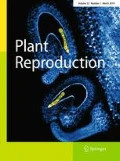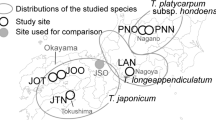Abstract
In natural populations where interfertile species coexist, conspecific and heterospecific pollen can be delivered to the stigmas. Post-pollination mechanisms might determine the seed siring success of different pollen donors within species as well as the chances for hybridization between species. Nicotiana longiflora and N. plumbaginifolia occur in sympatry in Northwest Argentina, where they have overlapping flowering seasons and share floral visitors. We explored (1) pollen tube growth rates for outcross versus self pollen in single-donor pollinations; (2) siring success of self versus outcross pollen donors in competitive pollinations, and (3) possibilities for hybridization by performing two- (outcross conspecific vs. heterospecific) and three-pollen donor (self vs. outcross vs. heterospecific) crosses. In N. longiflora, both pollen tube growth rate and siring success favored outcross pollen over self pollen and strong rejection of heterospecific pollen. In N. plumbaginifolia, pollen tube growth rate was similar for self and outcross pollen, self pollen sired similar numbers of offspring than outcross pollen and heterospecific pollen sired roughly the same number of progeny than self pollen. Results suggest that in natural sympatric populations, interspecific crosses would likely lead to unidirectional hybridization with N. plumbaginifolia as the seed parent.



Similar content being viewed by others
References
Aizen MA, Searcy KB, Mulcahy DL (1990) Among- and within-flower comparisons of pollen tube growth following self- and cross-pollinations in Dianthus chinensis (Caryophyllaceae). Am J Bot 77:671–676
Baker AM, Shore JS (1995) Pollen competition in Turnera ulmifolia (Turneraceae). Am J Bot 82:717–725
Bateman AJ (1956) Cryptic self-incompatibility in the wall-flower: Cheiranthus cheiri L. Heredity 10:257–261
Bernasconi G, Ashman T-L, Birkhead TR, Bishop JDD, Grossniklaus U, Kubli E, Marshall DL, Schmid B, Skogsmyr I, Snook RR, Taylor D, Till-Bottraud I, Ward PI, Zeh DW, Hellriegel B (2004) Evolutionary ecology of the prezygotic stage. Science 303:971–975
Bertin RI, Sullivan M (1988) Pollen interference and cryptic self-fertility in Campsis radicans. Am J Bot 75:1140–1147
Bowman RN (1987) Cryptic self-incompatibility and the breeding system of Clarkia unguiculata (Onagraceae). Am J Bot 74:471–476
Broyles SB (2002) Hybrid bridges to gene flow: a case study in milkweeds (Asclepias). Evolution 56:1943–1953
Carney SE, Cruzan MB, Arnold ML (1994) Reproductive interactions between hybridizing irises: analyses of pollen-tube growth and fertilization success. Am J Bot 81:1169–1175
Casper BB (1985) Self-compatibility in distylous Cryptantha flava (Boraginaceae). New Phytol 99:149–154
Casper BB, Sayigh LS, Lee SS (1988) Demonstration of cryptic incompatibility in distylous Amsinckia douglasiana. Evolution 42:248–253
Charlesworth D (1988) Evidence for pollen competition in plants and its relationship to progeny fitness: a comment. Am Nat 132:298–302
Chase MW, Knapp S, Cox AV, Clarkson JJ, Butsko Y, Joseph J, Savolainen V, Parokonny AS (2003) Molecular systematics, GISH and the origin of hybrid taxa in Nicotiana (Solanaceae). Ann Bot 92:107–127
Clarkson JJ, Knapp S, Garcia VF, Olmstead RG, Leitch AR, Chase MW (2004) Phylogenetic relationships in Nicotiana (Solanaceae) inferred from multiple plastid DNA regions. Mol Phylogenet Evol 33:75–90
Cruzan MB (1989) Pollen tube attrition in Erythronium grandiflorum. Am J Bot 76:562–570
Cruzan MB (1990) Pollen-pollen and pollen-style interactions during pollen tube growth in Erythronium grandiflorum (Liliaceae). Am J Bot 77:116–122
Cruzan MB, Barrett SCH (1993) Contribution of cryptic incompatibility to the mating system of Eichornia paniculata (Pontederiaceae). Evolution 47:925–934
de Nettancourt D (2001) Incompatibility and incongruity in wild and cultivated plants. Springer-Verlag, Berlin
Diaz A, Macnair MR (1999) Pollen tube competition as a mechanism of prezygotic reproductive isolation between Mimulus nasutus and its presumed progenitor M. guttatus. New Phytol 144:471–478
East EM (1916) Studies on size inheritance in Nicotiana. Genetics 1:164–176
Eckert CG, Allen M (1997) Cryptic self-incompatibility in tristylous Decodon verticillatus (Lythraceae). Am J Bot 84:1391–1397
Emms SK, Hodges SA, Arnold ML (1996) Pollen-tube competition, siring success, and consistent asymmetric hybridization in Louisiana irises. Evolution 50:2201–2206
Erbar C (2003) Pollen tube transmitting tissue: place of competition of male gametophytes. Int J Plant Sci 164:S265–S277
Fenster CB, Sork VL (1988) Effect of crossing distance and male parent on in vivo pollen tube growth in Chamaecrista fasciculata. Am J Bot 75:1898–1903
Figueroa-Castro DM (2008) Mating systems in Nicotiana longiflora and N. plumbaginifolia: the effect of interspecific interactions. Dissertation, University of Missouri
Franklin-Tong VE, Franklin FCH (2003) The different mechanisms of gametophytic self-incompatibility. Philos T Roy Soc B 358:1025–1032
Goodspeed TH (1954) The genus Nicotiana. Origins, relationships and evolution of its species in the light of their distribution morphology and cytogenetics. Chronica Botanica Company, Waltham, Massachussets
Haileselassie T, Mollel M, Skogsmyr I (2005) Effects of nutrient level on maternal choice and siring success in Cucumis sativus (Cucurbitaceae). Evol Ecol 19:275–288
Hessing MB (1989) Differential pollen tube success in Geranium caespitosum. Bot Gaz 150:404–410
Ippolito A (2000) Systematics, floral evolution and speciation in Nicotiana. Dissertation, University of Missouri
Ippolito A, Fernandes GW, Holtsford TP (2004) Pollinator preferences for Nicotiana alata, N. forgetiana, and their F1 hybrids. Evolution 58:2634–2644
Jones KN (1994) Nonrandom mating in Clarkia gracilis (Onagraceae): a case of cryptic self-incompatibility. Am J Bot 81:195–198
Kho YO, Baer J (1968) Observing pollen tubes by means of fluorescence. Euphytica 17:299–302
Kruszewski LJ, Galloway LF (2006) Explaining outcrossing rate in Campanulastrum americanum (Campanulaceae): geitonogamy and cryptic self-incompatibility. Int J Plant Sci 167:455–461
Lankinen A, Skogsmyr I (2002) Pollen competitive ability: the effect of proportion in two-donor crosses. Evol Ecol Res 4:687–700
Lee CB, Page LE, McClure BA, Holtsford TP (2008) Post-pollination hybridization barriers in Nicotiana section Alatae. Sex Plant Reprod 21:183–195
Lim KY, Kovarik A, Matyasek R, Chase MW, Knapp S, McCarthy E, Clarkson JJ, Leitch AR (2006) Comparative genomics and repetitive sequence divergence in the species of diploid Nicotiana section Alatae. Plant J 48:907–919
Marshall DL (1988) Postpollination effects on seed paternity: mechanisms in addition to microgametophyte competition operate in wild radish. Evolution 42:1256–1266
Marshall DL (1991) Nonrandom mating in wild radish: variation in pollen donor success and effects of multiple paternity among one- to six-donor pollinations. Am J Bot 78:1404–1418
Marshall DL, Diggle PK (2001) Mechanisms of differential pollen donor performance in wild radish, Raphanus sativus (Brassicaceae). Am J Bot 88:242–257
Marshall DL, Ellstrand NC (1985) Proximal causes of multiple paternity in wild radish, Raphanus sativus. Am Nat 126:596–605
Marshall DL, Ellstrand NC (1986) Sexual selection in Raphanus sativus: experimental data on nonrandom fertilization, maternal choice, and consequences of multiple paternity. Am Nat 127:446–461
Marshall DL, Oliveras DM (2001) Does differential seed siring success change over time or with pollination history in wild radish, Raphanus sativus (Brassicaceae)? Am J Bot 88:2232–2242
Marshall DL, Folsom MW, Hatfield C, Bennett T (1996) Does interference competition among pollen grains occur in wild radish? Evolution 50:1842–1848
Marshall DL, Shaner MGM, Oliva J-P (2007) Effects of pollen load size on seed paternity in wild radish: the roles of pollen competition and mate choice. Evolution 61:1925–1937
Martin NH, Willis JH (2007) Ecological divergence associated with mating system causes nearly complete reproductive isolation between sympatric Mimulus species. Evolution 61:68–82
Montalvo AM (1992) Relative success of self and outcross pollen comparing mixed- and single-donor pollinations in Aquilegia caerulea. Evolution 46:1181–1198
Rigney LP, Thomson JD, Cruzan MB, Brunet J (1993) Differential success of pollen donors in a self-compatible lily. Evolution 47:915–924
Shaner MGM, Marshall DL (2003) Under how wide a set of conditions will nonrandom mating occur in Raphanus sativus (Brassicaceae)? Am J Bot 90:1604–1611
Skogsmyr I, Lankinen A (1999) Selection on pollen competitive ability in relation to stochastic factors influencing pollen deposition. Evol Ecol Res 1:971–985
Snow AA, Spira TP (1991) Differential pollen-tube growth rates and nonrandom fertilization in Hibiscus moscheutos (Malvaceae). Am J Bot 78:1419–1426
Soule JW (2007) Heterochrony of floral and mating system characters between Nicotiana longiflora and N. plumbaginifolia. Master thesis, University of Missouri
Travers SE, Mazer SJ (2000) The absence of cryptic self-incompatibility in Clarkia unguiculata (Onagraceae). Am J Bot 87:191–196
Walsh NE, Charlesworth D (1992) Evolutionary interpretations of differences in pollen tube growth rates. Q Rev Biol 67:19–37
Weller SG, Ornduff R (1989) Incompatibility in Amsinckia grandiflora (Boraginaceae): distribution of callose plugs and pollen tubes following inter- and intramorph crosses. Am J Bot 76:277–282
Weller SG, Ornduff R (1991) Pollen tube growth and inbreeding depression in Amsinckia grandiflora (Boraginaceae). Am J Bot 78:801–804
Wendt T, Ferreira CMB, Gelli FAP, Iglesias RR (2001) Reproductive biology and natural hybridization between two endemic species of Pitcairnia (Bromeliaceae). Am J Bot 88: 1760–1767
Williams EG, Rouse JL (1990) Relationships of pollen size, pistil length and pollen tube growth rates in Rhododendron and their influence on hybridization. Sex Plant Reprod 3:7–17
Acknowledgments
The Electron Microscopy Core facility at University of Missouri provided the UV microscope to visualize pollen tubes. C. Galen provided the Elzone particle counter and a micrometer ocular to determine pollen size. J. Murfett provided DNA extraction and PCR protocols. J. Copa, F. Benicio, R. Guanuco, and L. Cejas helped locate the populations and collect the seeds used in this study. Two anonymous reviewers made very helpful comments that greatly improved this manuscript. The government of Argentina provided collection and exportation permits of seeds used for crosses in this study. C. B. Lee helped to set up the protocol for pollen tube growth rates. DMF-C was supported with a fellowship (#130046) provided by CONACyT.
Author information
Authors and Affiliations
Corresponding author
Additional information
Communicated by Andrew Stephenson.
Rights and permissions
About this article
Cite this article
Figueroa-Castro, D.M., Holtsford, T.P. Post-pollination mechanisms in Nicotiana longiflora and N. plumbaginifolia: pollen tube growth rate, offspring paternity and hybridization. Sex Plant Reprod 22, 187–196 (2009). https://doi.org/10.1007/s00497-009-0103-6
Received:
Accepted:
Published:
Issue Date:
DOI: https://doi.org/10.1007/s00497-009-0103-6




